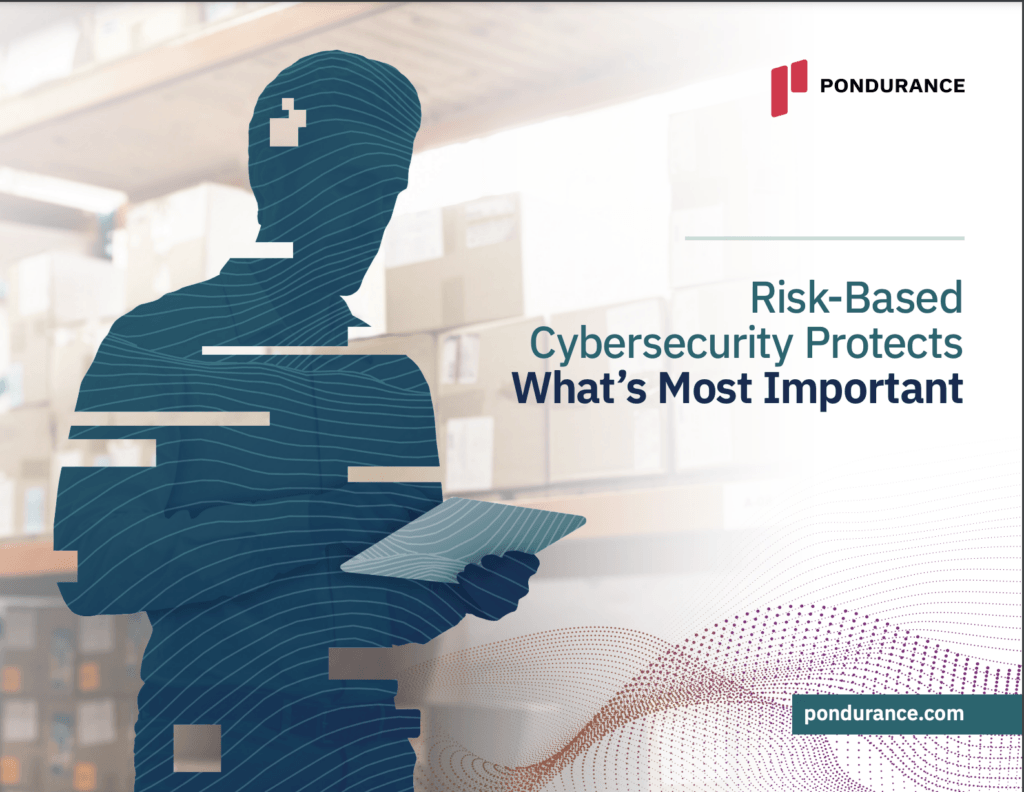Our privacy policy is located here.
Risk-Based Cybersecurity
Your cybersecurity approach should align with your company’s objectives, outcomes, and risks — making a risk-based approach to cybersecurity the best strategy for your business.
Cyber Risk Management Made Easy
With Pondurance's Risk-Based Approach
Defend What's Most Important
With a Risk-Based Cybersecurity Approach

Learn more about our risk-based approach, and dynamic defense methodology
Dustin Hutchison, Ph.D.
Protect What Matters Most with Risk-Based Cybersecurity
Pondurance — the first and only MDR provider to be built around a risk-based approach — believes a risk-based approach is the best way to protect clients from threats and reduce their exposure to attacks.

Learn more about a risk-based MDR approach
an Interview with ISMG and Doug Howard



Cyber Risk Management
In today’s interconnected digital world, cyber risk management emerges as a crucial strategy for organizations of all sizes and sectors to combat the ever-evolving spectrum of cyber threats. What exactly is cyber risk management, and why does it play such a pivotal role in mitigating these threats?
Cyber risk management encompasses a comprehensive strategy that involves identifying, assessing, and mitigating potential vulnerabilities and threats within a network. This ongoing process aims to protect organizations from cyber attacks by implementing a combination of administrative actions, technical solutions, and relevant cyber risk policies.
Understanding the importance of cyber risk management is paramount, considering the heavy reliance of businesses on digital technologies and data. A single cyber-attack can result in not only financial losses but also compromise the organizational identity, tarnish the brand image, and erode public trust. Robust cyber risk management strategies ensure prompt identification of threats, expedited responses, and significant mitigation of damages.
While AI and automation are valuable tools, human experience remains essential, as attackers are people, not machines. At Pondurance, for instance, our approach to managing cyber threats integrates our advanced platform with years of human intelligence, accelerating detection, response, and threat containment to reduce overall cyber risks.
In conclusion, the effectiveness of cyber risk management strategies relies on an organization’s understanding of its cyber infrastructure’s complexities, its risk landscape, and its ability to respond appropriately. Prioritizing cyber risk management goes beyond just preventing attacks; it’s about establishing a sustainable, resilient system capable of adapting, defending, and recovering even in the most challenging cyber threat scenarios.
Setting Up a Cyber Risk Management Framework
Introducing and fully operationalizing a cyber risk management framework is paramount in today’s digital landscape. An organization’s digital infrastructure is often targeted by cyber threats, requiring meticulous attention to cybersecurity companies and cyber risk management frameworks. Companies across a variety of sectors are realizing the importance of incorporating superior cyber risk protocols, to ensure the safety of their digital assets and maintain operational fluidity.
Setting up a cyber risk management framework is a strategic process that necessitates understanding of various components. It involves identifying crucial cyber risk sources, analyzing potential impacts, implementing comprehensive management controls, and constantly monitoring and enhancing the devised framework. What makes this process more comprehensive is the integration of NIST’s (National Institute of Standards and Technology) framework.
The NIST Cyber Risk Management Framework is a reliable structure that integrates industry standards and best practices to effectively manage cyber risks. Its core’s five key functions – Identify, Protect, Detect, Respond, and Recover – provide a strategic approach to managing cyber risk that goes beyond merely preventing attacks. The NIST guidelines streamline a security program’s focus towards comprehension of cybersecurity threats, the application of necessary safeguards, implementation of effective detection systems, developing a proficient response strategy, and ensuring swift recovery post-threat.
The NIST framework also promotes a culture of continuous assessment and systematic enhancement of cyber risk management. Aligned with its guidelines, organizations can fortify their cyber risk management frameworks and shield against potential cyber threats.
By integrating the principles of the NIST framework with a cyber risk management framework, organizations can operationalize a robust cyber risk management strategy. This tactful combination leads to quicker detection and response to cybersecurity threats, thereby reducing risks and ensuring the preservation of the organization’s mission. Furthermore, it exemplifies the belief that the amalgamation of advanced technology with human intelligence can create an impregnable security parameter that’s fast, effective, and reliable.
While setting up a cyber risk management framework demands proficiency and effort, it is a worthwhile investment. An organization’s commitment to this cause can revolutionize the way it perceives, responds to, and learns from cyber threats, making it resilient and steadfast in the face of an ever-evolving digital landscape.
Factors to Consider in Cyber Risk Management
Cyber risk management is an integral part of today’s organizational operations, given the dynamic nature of cyber threats. It is a necessary practice that not only protects the entity from potential cyber assaults but also limits the damage in unfortunate circumstances where the firm’s defenses are breached. Factors to consider in cyber risk management are vast, varied and interlinked; these factors range from the vulnerability of the systems in place, the type of data the organization retains, processes for identifying and managing risks, to the strategies set for incident response.
Notably, third-party cyber risk management emerges as a key factor. Third-party vendors often have access to an organization’s sensitive data or systems, making them potential weak links for cybersecurity breaches. If these vendors lack robust security measures, they can expose the enterprise to significant risks. Therefore, it’s vital to implement cybersecurity risk assessments, develop stringent data handling and access policies and ensure continuous monitoring of third-party vendors.
Meanwhile, a comprehensive cyber risk management process requires efficient and effective tools. This signals the importance of a cyber risk management platform. Such platforms offer a streamlined approach to managing cyber risk, providing a clear overview of the risk landscape, predicting potential threats, and assisting in strategic decision-making. They improve visibility across an organization’s cyber ecosystem, help identify vulnerabilities, and manage the response process when a cyber incident occurs.
Further, leveraging cyber risk management software is a forward-leaning step. These can enhance an organization’s threat detection capabilities, automate routine tasks, and facilitate better integration of cybersecurity measures across all operational levels. With machine learning and AI capabilities, this software can predict threats, enhancing the company’s preparation and response times.
In conclusion, a well-rounded cyber risk management strategy should holistically address these factors. At the heart of this lies human expertise and ingenuity complemented by intelligent technology. Alliances with cybersecurity specialists like Pondurance enrich an organization’s capacity to rapidly detect and respond to cyber threats. Pondurance amalgamates its top-notch platform with unparalleled human intelligence, decreasing risk and safeguarding your organization’s mission in the challenging cyber landscape.
Tools and Policies in Cyber Risk Management
In the era of digital revolution, organizations face an unprecedented challenge – digital threats. These threats, irrespective of an organization’s size or sector, underscore the critical importance of effective digital threat management. At its essence, digital threat management entails a strategic approach to identifying, evaluating, and addressing potential risks originating from digital environments.
Amidst the escalating digital threat landscape, a plethora of digital threat management tools have emerged to assist organizations in safeguarding their interests. These tools serve as effective instruments for detecting, assessing, and mitigating digital threats. They offer a wide range of services, including threat hunting and intelligence, incident response, strategic advisory, and more. By leveraging both machine and human intelligence, these tools deliver superior threat detection and rapid response, ultimately reducing overall risk levels.
Similarly, a well-defined digital threat management policy is crucial in shaping an organization’s response to digital threats. This policy comprises guidelines outlining the approach to managing various digital risks, such as protecting sensitive information, employee training on potential risks, and response protocols in the event of a security breach. A robust policy not only significantly lowers the risk of a cyberattack but also ensures better recovery if an attack occurs.
At Pondurance, we advocate for empowering organizations with advanced digital threat management tools and well-informed policies. Our advanced platform enables expedited detection and response to cybersecurity threats, while also mitigating risk to each organization’s unique mission. With decades of experience and continuous learning, we assist organizations in navigating the complex landscape of digital threat management.
In conclusion, effective risk management in the digital realm necessitates not only superior tools but also well-crafted policy frameworks. This integrated approach enables organizations not only to survive but also to thrive amidst the ever-evolving landscape of digital threats.
Future Trends and Strategies in Cyber Risk Management
In the technological age, cyber risk management has become a ubiquitous aspect transcending industries and organizations. Efforts to combat cyber threats are increasingly focused on future trends and strategies in cyber risk management. Companies like Pondurance are at the forefront, merging their advanced platforms with human intelligence to detect and respond to cyber threats. With cyber risk management strategies becoming integral to enterprises, integrated and automated defensive systems are leading the charge.
Integrated cyber risk management represents a forward-thinking strategy ensuring holistic protection against cyber threats. It synthesizes an organization’s strategy, processes, and technology to develop and implement effective cyber risk management strategies. This comprehensive approach mitigates risks across all organizational levels, leaving no process or technology exposed to potential threats.
Meanwhile, enterprise cyber risk management incorporates risk management into the broader business strategy, emphasizing cyber risk as an enterprise-wide concern affecting all aspects of business operations. This elevates cyber risk management into a strategic function aligned with overall business objectives, emphasizing proactive measures.
Although advancements like Artificial Intelligence (AI) and automation are significant, they do not encompass the entirety of cybersecurity measures. Truly effective cybersecurity balances these technologies with human expertise. As Pondurance advocates, attackers are people, not machines, underscoring the importance of human experience in shaping cyber risk management strategies. An effective fusion of technology and human intelligence is pivotal in thwarting cybersecurity threats and reducing overall risk.
Exploring current trends and future strategies in cyber risk management enables organizations to grasp the evolving landscape and implement effective solutions. As the threat landscape continues to evolve, organizations must remain agile and continually refine their strategies to stay ahead of potential threats. With such practices, we anticipate an era where cyber risk management seamlessly integrates into organizational processes, contributing to overall business growth.
